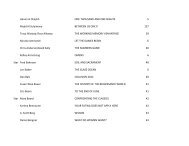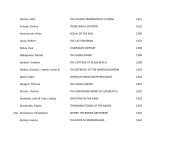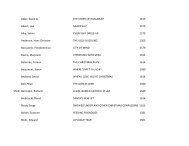nonfiction
nonfiction
nonfiction
You also want an ePaper? Increase the reach of your titles
YUMPU automatically turns print PDFs into web optimized ePapers that Google loves.
“… just before—before—a strong closing chapter,<br />
Pike interrupts with an Author’s Note, counseling, ‘if you prefer<br />
your endings happy… maybe you should stop reading here.’”<br />
from destined<br />
but this title has been formatted for slightly older readers. Its<br />
bold colors and interesting patterns have appeal, but both the<br />
experiences (plucking mushrooms) and the stilted language<br />
may be beyond even the kindergarten child.<br />
For die-cut surprises read Laura Vaccaro Seeger’s Lemons<br />
Are Not Red (2004) or Hervé Tullet’s The Book with a Hole<br />
(2011) instead. (Picture book. 5-7)<br />
DESTINED<br />
Pike, Aprilynne<br />
HarperTeen (320 pp.)<br />
$17.99 | May 1, 2012<br />
978-0-06-166812-8<br />
The bloom is off the rose in the conclusion<br />
of a paranormal romance featuring<br />
faeries who are, biologically, plants.<br />
At first (Wings, 2009; Spells, 2010),<br />
blond, zitless Laurel seemed idealized but<br />
unique: Laurel oozes sap (not blood) when<br />
injured, and the prose likewise was pleasant and refreshingly nonangsty<br />
for the genre. By this fourth volume, however, any freshness<br />
has faded. Four friends—faeries Laurel and Tamani, humans David<br />
and Chelsea—fight to defend idyllic Avalon against renegade faeries<br />
and ugly trolls. David wields Excalibur, echoing King Arthur,<br />
though the Arthurian theme never jells. Cliché (“A true hero knows<br />
love is more powerful than hate”) and purple prose (“A single tear,<br />
glistening in the moonlight, slid down her porcelain cheek”) sprout<br />
up, overwhelming vivid images and one particularly clever textual<br />
misdirection. Despite claiming a “deadly fast-forward” pace, fight<br />
scenes drag. Laurel hopes her love triangle will become a neat<br />
square (with David finally noticing Chelsea), but just before—<br />
before—a strong closing chapter, Pike interrupts with an Author’s<br />
Note, counseling, “if you prefer your endings happy… maybe you<br />
should stop reading here.” This bizarre Note disrupts the fiction<br />
and sabotages the last chapter’s emotional power—and its content.<br />
With mediocre exposition and with battles superseding<br />
the previous volumes’ fluttery abstinence-romance scenes,<br />
this won’t attract new fans, but it will gratify loyal followers<br />
by providing closure. (Paranormal romance. 13 & up)<br />
PUTTING ON THE BRAKES<br />
Understanding and<br />
Taking Control of<br />
Your ADD or ADHD<br />
Quinn, Patricia O. & Stern, Judith M.<br />
American Psychological Association/<br />
Magination (112 pp.)<br />
$16.95 | paper $12.95 | Apr. 1, 2012<br />
978-1-4338-1135-7<br />
978-1-4338-1134-0 paperback<br />
Minor revisions and new illustrations freshen up the third<br />
edition of an encouraging, if generalized, guide for young people<br />
with attention issues and their parents.<br />
Using simple language and addressing readers directly, the<br />
authors first define types of AD/HD and explain current thinking<br />
about its behavioral and neurological characteristics. They<br />
then go on to offer a basic set of tools and techniques for managing<br />
the disorder. These range from building a “Support Team”<br />
of adults to using yoga, self-initiated timeouts, medication and<br />
other means of controlling emotions and impulses. The authors<br />
close with a restatement of their central message, that “[your]<br />
AD/HD is just one part of you. Try hard to manage it, and you<br />
will have plenty of energy left over to enjoy the many other parts<br />
of your life.” Abstract cartoon drawings and photos of smiling<br />
children reinforce the overall positive tone. So inclusive is the<br />
message that, aside from a single mention that genuine AD/HD<br />
can only be diagnosed by a professional, nearly all the advice<br />
here about self-control, making friends, establishing good study<br />
habits and maintaining a healthy lifestyle could apply to anyone.<br />
More specific and extensive manuals and workbooks<br />
abound, but as a lucid guide to the disorder and its management,<br />
this has proven its worth over the past 20 years.<br />
(multilevel, multimedia resource lists) (Self-help. 9-12, adult)<br />
EXCUSES, EXCUSES!<br />
Ravishankar, Anushka<br />
Illus. by Manglou, Gabrielle<br />
Tara Publishing (46 pp.)<br />
$16.95 | May 1, 2012<br />
978-93-80340-12-8<br />
A narrator introduces readers to Neel,<br />
who, for every day of the week, makes a<br />
decision to better himself, then falls short—<br />
with good reason, as Neel himself explains in nonsense verse.<br />
The framework is clever, starting with the narrator providing<br />
the premise. What follows is a daily reckoning. Each<br />
day of the week is given a full spread, with the day appearing<br />
on the verso and a question or accusation from a teacher, parent<br />
or other unnamed authority figure on the recto. Turn the<br />
page, and youngsters will delight in Neel’s fantastic excuses.<br />
For example, on Wednesday, the voice proclaims, “Where’s the<br />
bread / You brought a dog instead” Neel hypothesizes that the<br />
dog hypnotized him: “I don’t know how I got back here, / and<br />
so, therefore, you see, / I didn’t bring the dog back home— / He<br />
brought me.” The rhythm sometimes stumbles, but the situations<br />
are recognizable—except for those that are so farfetched<br />
they will inspire admiration, such as when Neel shows up without<br />
socks, claiming he stuffed them into a panicked elephant’s<br />
ears. The illustrations, a collage of tinted photographs and art,<br />
provide an appropriately surreal backdrop. Unfortunately, the<br />
placement of text, the use of amorphous figures and the amount<br />
of blank space on some pages disrupt the flow and may leave<br />
readers feeling disengaged.<br />
An uneven, ambitious effort. (Picture book/poetry. 5-9)<br />
PAIUTE PRINCESS<br />
The Story of Sarah<br />
Winnemucca<br />
Ray, Deborah Kogan<br />
Illus. by Ray, Deborah Kogan<br />
Frances Foster/Farrar,<br />
Straus & Giroux (48 pp.)<br />
$17.99 | May 8, 2012<br />
978-0-374-39897-2<br />
Sarah Winnemucca’s fearless determination along with her<br />
talent for languages and her commitment to education for her<br />
people made her a striking spokesperson, lecturer and educator.<br />
Ray’s biography encompasses Winnemucca’s life from childhood<br />
through her work with the Peabody School she founded<br />
in 1885 in Lovelock, Nev. The heartbreak and challenges Sarah’s<br />
Paiute people experienced as gold and silver mining brought<br />
English-speaking settlers in droves to the Great Basin of Utah,<br />
Nevada and California form the core of the narrative. A picturebook<br />
trim size allows for substantial blocks of text to accompany<br />
Ray’s luminous full-page paintings, each focusing on a<br />
chapter of Winnemucca’s life. Quotations from Winnemucca’s<br />
autobiography as well as from other contemporary writings<br />
augment the account. Extensive backmatter offers more information<br />
about Winnemucca’s life (Ray explains that the term<br />
“princess” was conferred by white journalists) and her people,<br />
extending the range for this work well into middle school. The<br />
lack of page numbers or index is a slight problem for navigating<br />
back through the work, but the clarity of the narrative will<br />
make this an excellent read-aloud for older listeners.<br />
A compelling introduction to an extraordinary leader.<br />
(author’s note, map, timeline, bibliography) (Biography. 9-13)<br />
DON’T SQUISH<br />
THE SASQUATCH!<br />
Redeker, Kent<br />
Illus. by Staake, Bob<br />
Disney Hyperion (40 pp.)<br />
$16.99 | Jun. 19, 2012<br />
978-1-4231-5232-3<br />
Mr. Sasquatch tempts fate—a good squishing—when he<br />
boards Mr. Blobule’s city bus.<br />
“Hello, Mr. Blobule! May I please ride your bus” asks Mr. Sasquatch<br />
to open this gladdening bit of tomfoolery from Redeker.<br />
Traveling through a city where French curves meet plane geometry<br />
in a style as idiosyncratic as Art Deco and all Staake’s own, others<br />
ask to ride the bus. There are Miss Goat-Whale, Mr. Octo-Rhino,<br />
Miss Loch-Ness-Monster-Space-Alien, all in a roundelay of “ ‘May I<br />
please ride your bus’ / ‘Of course you may ride my bus…. But please…<br />
// Don’t squish the Sasquatch!’ ” Who, of course, gets more squished<br />
with each new rider, his eyes rotating, his hat boinging off, his arms<br />
flailing, until—”KA-BLOOEY!!” This work will not be denied<br />
engagement, whether children join the circle dance of words, with<br />
their simple, sunny musicality, or pore closely over the fanciful city<br />
the bus passes through. Mr. Sasquatch’s final delamination takes<br />
place in a fine, eruptive double-gatefold, which inspires a group hug,<br />
which triggers Mr. Sasquatch’s claustrophobia switch again.<br />
Pure, disarming horseplay served on a bed of charismatic<br />
artwork. (Picture book. 1-5)<br />
HOW<br />
The Most Awesome<br />
Question and Answer<br />
Book about Nature,<br />
Animals, People,<br />
Places—and You!<br />
Ripley, Catherine<br />
Illus. by Ritchie, Scot<br />
Owlkids Books (192 pp.)<br />
$19.95 | $19.95 e-book | May 15, 2012<br />
978-1-926973-24-1<br />
978-1-926973-25-8 e-book<br />
Lightweight answers to FAQs about such subjects as birthdays,<br />
libraries, pets and road trips.<br />
In question-and-answer format—with each one allotted a<br />
two-page spread and accompanied by Ritchie’s loose-line, pastelcolored<br />
artwork—Ripley fields a range of questions. They include<br />
how batter turns into cake and how birthday candles stay on fire,<br />
why hamsters run on wheels and why they stuff their cheeks with<br />
food, why you hear the sea in a seashell and why the ocean is salty.<br />
The answers are both fruity with humor and specific as to the<br />
immediate explanation, but there is not much meat on the bones<br />
to many of the answers, even for the intended age group. This<br />
is true especially when it comes to secondary clarifications that<br />
would deepen understanding, because these answers are going<br />
to elicit plenty more “hows” and “whys.” Some of the questions<br />
ignite the “duh” factor: “Why do we wrap presents Because<br />
surprises are fun! And because wrapping makes gifts look extra<br />
special.” There is a modest sense of repetition: “Why are some<br />
books hardcover and some paperback Because different<br />
readers like different kinds of books!” (nor does the extended<br />
response do any better a job of answering the question) and<br />
“Why are dogs different sizes Different dogs for different<br />
folks!” Then come really sharp explanations as to why tarantulas<br />
have hair and why gasoline has a strong odor.<br />
An uneven effort that is too often unhelpfully simplistic.<br />
(Nonfiction. 5-8)<br />
DUCK SAYS DON’T!<br />
Ritchie, Alison<br />
Illus. by George, Hannah<br />
Good Books (26 pp.)<br />
$16.99Jun. 1, 2012<br />
978-1-56148-745-5<br />
Goose leaves Duck in charge when she<br />
leaves her pond, with unhappy results.<br />
Power goes immediately to Duck’s head. First, he stops the<br />
dragonflies from racing, although they point out that flying is<br />
868 | 15 april 2012 | children’s & teen | kirkusreviews.com |<br />
| kirkusreviews.com | children’s & teen | 15 april 2012 | 869






